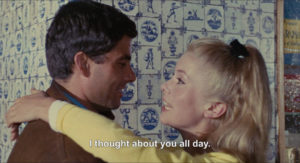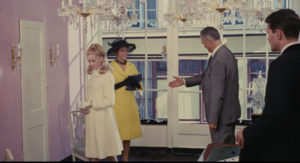I love musicals because the songs are always so catchy and they make you want to get up and dance with the music. You can’t tell me that you haven’t blasted Disney songs in the car while singing at the top of your lungs— If you haven’t, you’re missing out on a good time. Les Parapluies de Cherbourg, or The Umbrellas of Cherbourg, has one song that’s heard throughout the entirety of the film, which is extremely purposeful. Directed by Jacques Demy in 1964, the movie doesn’t have any musical numbers or backup dancers because the dialogue is the song. It is colorful and bright, leaving you with a skip in your step once you finish watching it.
A part of the French New Wave for directors was finding their direction and aiming at becoming an auteur – don’t worry if you’re not familiar with the word ‘auteur’, i’ll tell you what it means; it is a term for a director with such high creativity and powerful, personal vision that they are given the title as the film’s author. Usually, once given the title of auteur, they are considered someone that has paved the way in the film industry for future filmmakers and a shining example of what originality and influence means. For example, you could look at the movies from François Truffaut we have covered. Each of them has a solemn tone, but they also follow a distinct style – Truffaut’s style. Shoot the Piano Player uses different techniques than The 400 Blows, but both are masterpieces and part of Truffaut’s legacy. A more contemporary auteur would be a director such as Tim Burton. Without even saying a film title, you probably could think of a few of his films and their styles just based on reading his name. Likewise, Demy has lived up to his auteur status with The Umbrellas of Cherbourg.
The story takes place in three parts: firstly, “the departure”; secondly, “the absence”; and thirdly, “the return”. These three parts take place over the time span of three years. We follow the life of a 16-year-old girl named Geneviève Emery (Catherine Deneuve) and a 20-year-old Guy Foucher (Nino Castelnuovo), who are deeply in love. The couple is sappy, lovey-dovey, and head-over-heels for each other. I’m all for cute couples, but their relationship takes the cake for uber-sappy and overly-cutesy.

Guy (Nino Castelnuovo) and Geneviève (Catherine Deneuve) talk to each other in the beginning of the film.
The city of Cherbourg in the film is actually not a real place. However, there is a city called Cherbourg-Octeville located in northern France that is also a harbor city, but looks nothing like the film. The set seems a little phony, but that is the point. Since it is a musical, the town is meant to look more like a set you would see on a stage. For example, there is a scene where Guy and Geneviève are on the docks talking about their future together, some glowing red bits on the metal behind and in front of them. I’m not sure if they are meant to look like rust, or possibly to give the setting a little pizzazz, but either way, you can tell the lights are projected onto the set. This makes the scene more magical than a standard dock would typically look at night.

Guy and Geneviève talk at the docks.
The set uses color blocking to represent a little bit of personality from each character. It is one of the things that stands out the most about the setting. Everywhere you look, there are bright colors. Even the extras wear bright yellow raincoats or vibrant red jackets. Guy and Geneviève’s rooms are both blue, representing loyalty to each other. Madame Emery’s room is red, red usually representing strength, power or success. As a mother, she must stay strong for Geneviève and she wants to be successful with her umbrella shop. Aunt Elise (Mireille Perrey), who is the Godmother to Guy, has a green room, due to her sickness. Madeleine (Ellen Farner), who is the caretaker for Aunt Elise, is shown in orange towards the end of the film. She helps Guy recover and get back to everyday life when he comes back from his service, hence why orange was used, since the color often represents enthusiasm and emotional strength.

Madame Emery’s room.
Even in shorter scenes the setting combines well with what is going on in the storyline. There is a brief scene where Madame Emery and Geneviève go to a jewelry store to sell a pearl necklace so they can pay off their debt. The jeweler and Madame Emery seem to go way back, and they have known each other for quite some time, but he says his hands are tied and he cannot sell her necklace. Another man by the name of Roland Cassard steps in and offers to buy the jewelry, saving them from having to live on the streets. Their situation is very time-sensitive, and Mr. Cassard shows compassion by helping them out. The jewelry shop has light pink walls, representing sensitivity and compassion, reflecting the situation. Later in the story, when Geneviève becomes pregnant, she wears one solitary color – gray. Gray tends to represent detached, ambivalent feelings. Her life has lost meaning without Guy, and she pities herself when she looks in the mirror. Using strong color blocking and incorporating it into the background enhances the viewing experience and illustrates who the characters are in a non-verbal way. The photos don’t do justice to just how visually beautiful the film is.

Madame Emery and Geneviève at the jewelry store.
The musical score was written by Michel Legrand, a well-known French music composer that wrote the scores for other Demy films too, and while the dialogue is all sung, it is not over the top. Nobody holds their notes for a long time, loudly sings into the sky, or anything too dramatic. The film takes inspiration from operas or stage musicals, and in stage musicals, the songs are incorporated into the storyline seamlessly. Sometimes they ignore normality rules—like dancing on tables and having random people sing along— but most times, the theme of the song would work as a conversation. If the characters in The Umbrellas of Cherbourg were to speak the lines, it would work out just as well. The music throughout most of the film – besides the singing – is light and jazzy. The ending hits you hard when you realize that the two characters who loved each other so much had grown apart, and there was no way of them getting back together. The elegant music perfectly accompanies the slow pan out of the gas station— the gas station that Guy always dreamed of owning— on a snowy night, just after Guy and Genevieve meet up again for the first time in years and each have their own families, but say goodbye content with their own lives.
When the film began, I thought the first scene was an immediate dance number, but they just kept singing and singing. It was a strange adjustment since I have never seen a film like this before, but I enjoyed each incredible second of it. The acting and storyline are so well done that you barely notice they are singing after a while. The film movement isn’t just about questioning the melancholy existence of what we call life, Demy created a new branch stemming from the base of hundreds of other French New Wave Films. He has stretched the boundaries of what constitutes a musical and made it entertaining and fun to watch.

Recent Comments